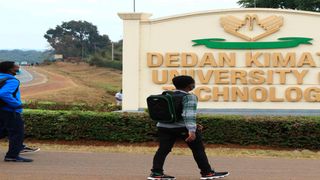
The entry to Dedan Kimathi University in Nyeri County. To determine the need level of a student, the Universities Fund and Helb will use the means testing instrument.
| File | Nation Media GroupEducation
Premium
Inside funding model for varsity, college education
The new funding model for higher education will spark competition among universities as they fight for students and money, stakeholders say.
Since funding will be directly to the student as opposed to the past when money was sent to the institutions, Kenya is likely see universities and colleges compete for relevance.
“Universities must attract students. Courses offered must have a relationship with the job market. We want to put more money in loans, with the ultimate goal being to have university education funded at 80 per cent loans and 20 per cent scholarship,” Kenya Universities and Colleges Central Placement Service (Kuccps) CEO Agnes Mercy Wahome said.
It is a shift from the earlier model in which the government was to pay 80 per cent of the differentiated unit cost (DUC) of a course and the student met the rest from family kitty or the Higher Education Loans Board (Helb).
“It’s good to be nice but is it practical? It means we can support more and universities can stabilise and do what they’re supposed to do. There will be no more moonlighting by lecturers because they’ll get better pay and do research,” Dr Wahome said.
Students from families categorised as less needy will pay more in the new model that has been described as “pro-hustler” as the vulnerable get full government scholarships, loans and bursary.
The model aims to shift government support from automatic grants to student loans sustained by a revolving fund and scholarships. It will be jointly implemented by three higher education agencies – Kuccps, Helb and the Universities Fund (UF).
UF Chief Executive, Geoffrey Monari, said the aim is to create a sustainable revolving fund.
“DUC wasn’t working for the student and university. Because of increasing enrolment and funding remaining the same, government contribution dropped to 48 per cent. Universities now have huge debts. The quality of education has been affected because of the debts. Universities couldn’t pay salaries or remit statutory deductions. Had DUC continued, funding would have dropped to 21 per cent by 2027/28,” Mr Monari said.
He added that the UF is developing a higher education information management system to be used to track a student’s progress. It will also be linked to state agencies for data-sharing.
Also Read: Parents’ pain in university funding plan
“In this model, the poor get the least in terms of loans but more in scholarship while the less needy get higher loans and less scholarship. If we burden the poor with huge loans at the end of their studies, it becomes a lifetime responsibility,” he said.
“I see stability in the next five years. We’ll see a revolution in higher education.”
Dr Wahome said more than 84,000 students who qualified for university admission had updated their details on the portal by Friday after Kuccps opened it two days earlier for the first revision of courses.
The model will come into force when students who sat the 2022 Kenya Certificate of Secondary Education (KCSE) tests join universities and technical and vocational education and training (Tvet) institutions in September. Continuing learners are not affected.
Polygamists, single parents
Kuccps displayed the annual cost of every programme to guide students in making choices.
The price introduced a new component in how students will be choosing universities and colleges.
“Parents and students should take their time in making the decision, especially the cost component. They should not leave their information at cyber cafes but use Huduma centres, which are free,” Mr Monari said.
Dr Wahome said students in the 2022 KCSE exam class will pay the fee indicated on the portal until they complete studies.
For subsequent learners, however, prices will vary according to the performance of the economy as advised by the Kenya National Bureau of Standards.
Universities will not be allowed to change their declared capacity without approval from the Commission for University Education.
To determine the need level of a student, the UF and Helb will use the means testing instrument (MTI) in granting loans.
Based on previous data, agencies say about 45,000 of university students and 42,000 joining Tvet fall under the vulnerable and extremely needy categories, therefore being guaranteed of full sponsorship.
For those in the needy and less needy categories, percentages will depend on an individual’s background.
According to Mr Monari, vulnerable students make up 14 per cent of the population, extreme needy (15 per cent), needy (17) and the less needy (54).
From the 2022 KCSE examination class, some 173,27 students scored the university entry grades of C+ and above.
Students who opt for private universities will only qualify for the Helb loan but not government scholarship.
Helb lending head, Ndegwa King’ori, said the agency’s financial portfolio has been damaged by about 120,000 former students not servicing their loans.
“We’re smoking them out in the next two months,” he said, adding that the MTI would among other things consider the previous school attended (public or private), family size and composition (polygamous, monogamous, single parent, orphan) age of parents, marginalisation, course, parents’ background, those on government cash transfer schemes, gender and expenditure on education for siblings.
“We’re digital and everything will be verified,” Mr King’ori said.
He added that students will apply for funding from August after Kuccps releases the placement results. Disbursement will be the following month.
Students will apply for the scholarship and loan using one link.
However, the scholarship will be processed by UF while Helb gives the loan. These will be paid to the institution.
Apart from the money going to the institutions, students qualify for Helb loan for upkeep.





